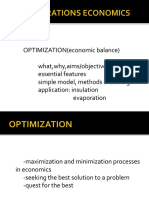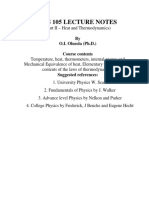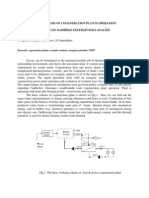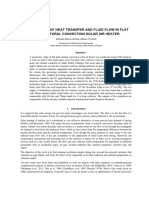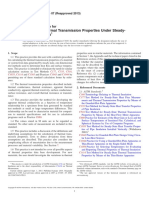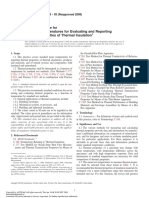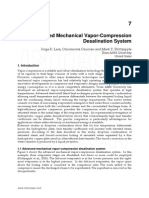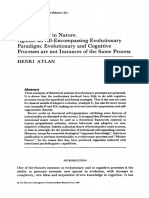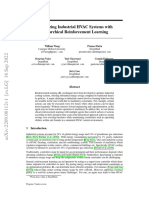Viorel Badescu 4
Viorel Badescu 4
Uploaded by
Asmaa RamadanCopyright:
Available Formats
Viorel Badescu 4
Viorel Badescu 4
Uploaded by
Asmaa RamadanOriginal Description:
Copyright
Available Formats
Share this document
Did you find this document useful?
Is this content inappropriate?
Copyright:
Available Formats
Viorel Badescu 4
Viorel Badescu 4
Uploaded by
Asmaa RamadanCopyright:
Available Formats
Optimal control of solar
energy systems
Viorel Badescu
Candida Oancea Institute
Polytechnic University of Bucharest
Contents
1. Optimal operation - systems with water
storage tanks
2. Sizing solar collectors
3. Optimal operation - maximum exergy
extraction
4. Sizing solar collection area
5. Conclusions
0. Introduction
This talk shows how the classical
methods of optimal control can be used
by the solar energy engineer.
Four applications will give a broad idea
about the usefulness of these
optimization procedures.
4. Sizing solar collection area
The optimization depends on the way the investor
uses the thermal energy obtained from solar energy
conversion
Two objectives:
First, to develop a sizing procedure for collection
surface area, with input variables:
the working fluid mass flow rate and
the inlet and outlet fluid temperatures
Second, propose a procedure to find the best local
design solution;
It may be implemented by using various objective
functions
1. Sizing solar collection area
Some economical indices, including
net present value and
internal return rate,
are examples of objective functions.
V Badescu, Optimum size and structure for solar energy
collection systems, Energy 31 (2006) 1483-1499
Model
The user
may need
heat or
work fluxes
The
classical
system
may
provide
heat or
work fluxes
The optimization problem
A (primary) conventional energy transfer system
A (secondary) system based on solar energy
conversion.
cT - total energy transfer cost per unit time,
c1 - cost of one energy unit received/removed by using the
primary system
c2 - investment and operation costs of the secondary system
The optimization problem:
find the surface area A which minimizes the costs
and the optimal structure of the collection system.
( ) ( ) A c F F c A c
u nec T 2 1
+ =
Model
The mass flow rate is
fixed
The fluid exits the area
A at temperature T
Adding area dA
increases the
temperature by delta_T
Solar collector model
Absorbed heat flux
Lost heat flux
Useful heat flux = absorbed - lost
Model
Integration of Hottel-Whillier-Bliss eq. (in J):
The time averaged form is (in W):
The time-averaged efficiency
( ) ( ) | | { }dt dA T T F U F G dt dT c m
t
a fi R L R
t
p
}
=
}
A A
0
* * * * *
0
* *
0
*
q
( )dA T U G dT c
F
~
~
0
= q
( ) G T U GdA dT c
F
/
~
~
/
0
= q q
Applications
(a)
The energy transferred is a heat rate received by a body and
the primary energy transfer system is a conventional heater.
(b)
The energy transferred is a heat rate received by a body at
temperature Ta+T and
the primary energy transfer system is a vapor compression
heat pump.
(c)
The energy transferred is a heat rate extracted from a body
at temperature
and the primary energy transfer system is an absorption
refrigerator.
The difference consists in the factors Fnec and Fu
( ) 0 > A A T T T T
a vap
Case (a) as an example
All energy
fluxes
involved are
heat fluxes
Case (a)
Fnec and Fu are heat fluxes
The increase of the heat rate supplied by the
solar energy conversion system,
associated to the increase of collection area dA
is:
Then, the economical benefit is
dT c dF
F
a
u
=
a
u
dF
dA G c dT c c dF c d
a
F
a a
u
a a
q
1 1 1
$ = = =
Economical indicators
The so called revenue factor R
cost of saved primary energy over cost of
surface area
The cost C_A per unit time of the solar
energy collection surface area A:
2
1
c
G c
R
a
a
q
=
}
=
}
=
2
1
2
0
2
T
T
F
A
A
dT
G
c c
dA c C
q
Economical indicators
the net present value (NPV)
the present value of cash inflows is
subtracted by the present value of cash
outflows.
( )
( )
}
|
|
.
|
\
|
A
A
=
A
2
1
2 2
1
2 1
2 1
,
,
T
T
tot
a
tot F
a
a
red
dT Y
G
c
Y
G
c
t
t
c
t c
T T NPV
T T NPV
q q
Economical indicators
the internal rate of return (IRR) is the interest rate that makes
NPV equal zero.
It is the return that a company would earn if they expanded or
invested in themselves, rather than investing that money abroad
The
may be found by solving numerically the associated equation
( ) ( ) c b a i T T IRR
i
, , ,
2 1
=
( ) ( ) c b a i T T NPV
i
, , 0 ,
2 1
= =
Examples
Results
The revenue factor R exceeds unity in case
the inlet working fluid temperature
exceeds a certain threshold value,
depending on solar collector design (Fig.
c).
The four threshold temperatures are
lower than 50 degrees.
The temperature threshold values in
case of are around 60 degrees for
collectors I and II.
The other two collectors have poor
economical performance as the
associated NPV is negative for all
operation temperatures (Fig. a).
The IRR values of Fig. b show the
collector I may be used economically for
T between 55 and 70 degrees while
collector II is recommended for operation
at more than 60 degrees.
Collectors III and IV are not
recommended as the associated IRR
values do not exceed the interest rate for
all T values.
Results
Different economical
indicators induce
different hierarchies
over the set of solar
collectors.
Results
Let us consider a part of the
collection surface consisting
of a single type of collector.
Integration of the efficiency
definition yields the
necessary surface area
The necessary collection
area is slightly smaller for
collector I than for collector
II.
Therefore, if a single type of
collector must be used,
collector I should be
selected.
In case both types of
collectors are available, a
better solution exists.
( )
}
=
2
1
/ ,
2 1
T
T
F
G
dT
c T T A
q
Solar collectors with optimal non-
uniformly distributed parameters
It was proved that systems consisting in
combinations of different collector types may
be a better solution
than systems consisting of a single collector
type.
One could imagine the extreme case of a
collection system with continuously space
variable parameters.
Such a system may be optimized from the
point of view of a given economical indicator.
Optimisation
The cost
is optimised if:
One finds
( )
( )
( )
}
=
2
1
~
,
~
~
,
~
~
,
~
0
0 2
0
T
T
F
A
dT
G U
c U c
U C
q q
q
q
0
~
/
~
/
0
= c c = c c U C C
A A
q
0
2
2 0
~
1
~
~
~
1
q q
q
q c
c
=
c
c c
c
U
c
c
U
~
1
~
~
~
1
2
2
c
c
=
c
cq
q
Theorem
The following condition should be fulfilled by
the optimum parameters distribution:
Theorem. The modified optical efficiency
and the modified overall heat loss coefficient
in an optimal collection system are distributed
in such a way that the gradient of
in the bi-dimensional parametric space
vanishes
0
~
ln
2
~
,
~
0
=
(
|
|
.
|
\
|
V
c
U
q
q
( )
2
/
~
ln c q
( ) U
~
,
~
0
q
Results
For very small values of T
the unglazed solar
collector is the best
economical solution for
both applications (Fig a).
When increases T a
single transparent layer
collector should be used.
The threshold
temperature for which N
jumps from 0 to 1 is
smaller for the cold
season application.
A collector without bottom
thermal insulation is the
best solution at very small
temperatures (Fig. b).
Conclusions
The general theorem proposed here shows
how the modified optical efficiency and heat
loss coefficient should be distributed for cost
minimization.
One finds that unglazed, single-glazed and
double-glazed collectors should be used on
the same collection area in order to obtain the
best performance.
Also, the bottom insulation thickness should
be changed accordingly.
End of part 4/4
Thank you!
You might also like
- Examples of Psychrometric Calculations For Summer and WinterNo ratings yetExamples of Psychrometric Calculations For Summer and Winter50 pages
- Applied Energy: Ci. Ambrosone, A. Andretta, F. Bloisi, B. Coluzzi, S. de Stefano, GNo ratings yetApplied Energy: Ci. Ambrosone, A. Andretta, F. Bloisi, B. Coluzzi, S. de Stefano, G13 pages
- Thermal Performances of Stirling Engine Solar DrivenNo ratings yetThermal Performances of Stirling Engine Solar Driven10 pages
- The Second Law of Thermodynamics: Conceptual ProblemsNo ratings yetThe Second Law of Thermodynamics: Conceptual Problems84 pages
- MEEG 346 Thermal Laboratory: Experiment #4: The Four-Stroke Combustion EngineNo ratings yetMEEG 346 Thermal Laboratory: Experiment #4: The Four-Stroke Combustion Engine9 pages
- Effect of Various Parameters On Indirect Fired Water Bath Heaters' Efficiency To Reduce Energy Losses100% (1)Effect of Various Parameters On Indirect Fired Water Bath Heaters' Efficiency To Reduce Energy Losses8 pages
- OPTIMIZATION (Economic Balance) What, Why, Aims/objectives Essential Features Simple Model, Methods of Solving Application: Insulation Evaporation100% (1)OPTIMIZATION (Economic Balance) What, Why, Aims/objectives Essential Features Simple Model, Methods of Solving Application: Insulation Evaporation93 pages
- A Thermo-Economic Analysis of Working Fluid and Cycle Combinations For Industrial Heat Pump ApplicationsNo ratings yetA Thermo-Economic Analysis of Working Fluid and Cycle Combinations For Industrial Heat Pump Applications14 pages
- Energy Performance Assessment of Hvac SystemsNo ratings yetEnergy Performance Assessment of Hvac Systems7 pages
- Technical-Theoretical Foundations __ T_SOL® helpNo ratings yetTechnical-Theoretical Foundations __ T_SOL® help5 pages
- Thermal Performances of Stirling Engine Solar DrivenNo ratings yetThermal Performances of Stirling Engine Solar Driven10 pages
- Application For Pinch Design of Heat Exc PDFNo ratings yetApplication For Pinch Design of Heat Exc PDF9 pages
- Paper 4 - Energy Auditor - Set B Key: General InstructionsNo ratings yetPaper 4 - Energy Auditor - Set B Key: General Instructions12 pages
- Towards Optimal District Heating Temperature Contr-3No ratings yetTowards Optimal District Heating Temperature Contr-31 page
- Paper 4 - Energy Auditor - Set A Key: General InstructionsNo ratings yetPaper 4 - Energy Auditor - Set A Key: General Instructions12 pages
- Heat Exchanger Network (HEN) Costs and Performances Estimation For Multi-Period OperationNo ratings yetHeat Exchanger Network (HEN) Costs and Performances Estimation For Multi-Period Operation6 pages
- Application of Design Space Approach To Solar Water Heating Systems With Pressurized StorageNo ratings yetApplication of Design Space Approach To Solar Water Heating Systems With Pressurized Storage6 pages
- School of Physics and Astronomy: File Topic07 PDFNo ratings yetSchool of Physics and Astronomy: File Topic07 PDF3 pages
- A Distributed Predictive Control Approach To Building Temperature RegulationNo ratings yetA Distributed Predictive Control Approach To Building Temperature Regulation6 pages
- Energy Optimization Using Pinch Analysis: Practical ConsiderationsNo ratings yetEnergy Optimization Using Pinch Analysis: Practical Considerations10 pages
- The Energetic and Exergic Performance of Gas Turbine Cogeneration SystemNo ratings yetThe Energetic and Exergic Performance of Gas Turbine Cogeneration System6 pages
- Phs 105 Lecture Notes: by O.I. Olusola (PH.D.) Course ContentsNo ratings yetPhs 105 Lecture Notes: by O.I. Olusola (PH.D.) Course Contents7 pages
- An Exergetic Analysis of Cogeneration Plants Operation Koģenerācijas Staciju Darbības Ekserģētiskā AnalīzeNo ratings yetAn Exergetic Analysis of Cogeneration Plants Operation Koģenerācijas Staciju Darbības Ekserģētiskā Analīze6 pages
- Livre Fundamental Mechanics of Fluids (M.dekker)No ratings yetLivre Fundamental Mechanics of Fluids (M.dekker)21 pages
- Heat Exchanger Network Retrofit by Pinch Technology On Reformer Area of Aromatics PlantNo ratings yetHeat Exchanger Network Retrofit by Pinch Technology On Reformer Area of Aromatics Plant10 pages
- Optimization of Diameter Ratio For Alpha-Type Stirling EnginesNo ratings yetOptimization of Diameter Ratio For Alpha-Type Stirling Engines6 pages
- A Case Study for a Single-Phase Inverter Photovoltaic System of a Three-Bedroom Apartment Located in Alexandria, Egypt: building industry, #0From EverandA Case Study for a Single-Phase Inverter Photovoltaic System of a Three-Bedroom Apartment Located in Alexandria, Egypt: building industry, #0No ratings yet
- Selecting Temperatures For Evaluating and Reporting Thermal Properties of Thermal InsulationNo ratings yetSelecting Temperatures For Evaluating and Reporting Thermal Properties of Thermal Insulation3 pages
- Internal Combustion Engines290963208 PDFNo ratings yetInternal Combustion Engines290963208 PDF2 pages
- Jindal Power Limited Draft Red Herring Prospectus PDFNo ratings yetJindal Power Limited Draft Red Herring Prospectus PDF523 pages
- Seawater Desalination: Trends and Technologies: Val S. Frenkel, PH.D., P.E., D.WRENo ratings yetSeawater Desalination: Trends and Technologies: Val S. Frenkel, PH.D., P.E., D.WRE12 pages
- Solar Thermal Desalination Technologies: Hazim Mohameed Qiblawey, Fawzi BanatNo ratings yetSolar Thermal Desalination Technologies: Hazim Mohameed Qiblawey, Fawzi Banat12 pages
- Combined Refrigeration Cycle For Thermal Power Plant Using Low Grade Waste SteamNo ratings yetCombined Refrigeration Cycle For Thermal Power Plant Using Low Grade Waste Steam4 pages
- Advanced Mechanical Vapor-Compression Desalination System: Jorge R. Lara, Omorinsola Osunsan and Mark T. HoltzappleNo ratings yetAdvanced Mechanical Vapor-Compression Desalination System: Jorge R. Lara, Omorinsola Osunsan and Mark T. Holtzapple22 pages
- Application of Renewable Energies For Water DesalinationNo ratings yetApplication of Renewable Energies For Water Desalination32 pages
- Water Desalination by Membrane Distillation: West Pomeranian University of Technology, Szczecin PolandNo ratings yetWater Desalination by Membrane Distillation: West Pomeranian University of Technology, Szczecin Poland22 pages
- Markov Decision Processes and Exact Solution MethodsNo ratings yetMarkov Decision Processes and Exact Solution Methods34 pages
- Quantitative Technique and Operations Research (Assignment) 1.what Are The Applications of Operation Research in Modern Business?No ratings yetQuantitative Technique and Operations Research (Assignment) 1.what Are The Applications of Operation Research in Modern Business?7 pages
- An Introduction To Management Science Quantitative Approaches To Decision Making 14th Edition Test Bank AndersonNo ratings yetAn Introduction To Management Science Quantitative Approaches To Decision Making 14th Edition Test Bank Anderson22 pages
- HENRI ATLAN - Intentionality in Nature. Against An All-Encompassing Evolutionary Paradigm - Evolutionary and Cognitive Processes Are Not InsNo ratings yetHENRI ATLAN - Intentionality in Nature. Against An All-Encompassing Evolutionary Paradigm - Evolutionary and Cognitive Processes Are Not Ins21 pages
- Module 2 - The Framework and Process of Business Analytics100% (1)Module 2 - The Framework and Process of Business Analytics9 pages
- Design Optimization of Shear Wall High-Rise Building StructuresNo ratings yetDesign Optimization of Shear Wall High-Rise Building Structures11 pages
- 2018 - Scopus - Optimisation of Resistance Spot Welding Process For Real Unconstrained and Constrained Scenarios Using Cuckoo Search AlgorithmNo ratings yet2018 - Scopus - Optimisation of Resistance Spot Welding Process For Real Unconstrained and Constrained Scenarios Using Cuckoo Search Algorithm21 pages
- A Topology Control Algorithm Taking Into Account Energy and Quality of Transmission For Software-Defined Wireless Sensor NetworkNo ratings yetA Topology Control Algorithm Taking Into Account Energy and Quality of Transmission For Software-Defined Wireless Sensor Network10 pages
- Shea & Cagan, Innovative Dome Design - Applying Geodesic Patterns With Shape Annealing, 1997 AIEDAMNo ratings yetShea & Cagan, Innovative Dome Design - Applying Geodesic Patterns With Shape Annealing, 1997 AIEDAM16 pages
- Preface To The Second Edition Preface To The First Edition Xi XiiiNo ratings yetPreface To The Second Edition Preface To The First Edition Xi Xiii6 pages
- Ship Structural Members Design and Optimization Based On Knowledge-Based EngineeringNo ratings yetShip Structural Members Design and Optimization Based On Knowledge-Based Engineering6 pages
- Deployment of The Electric Vehicle Charging Station Considering Existing CompetitorsNo ratings yetDeployment of The Electric Vehicle Charging Station Considering Existing Competitors13 pages
- Ant Colony Optimization: Quadratic Assignment ProblemNo ratings yetAnt Colony Optimization: Quadratic Assignment Problem13 pages
- (DeepMind) Optimizing Industrial HVAC Systems With Hierarchical Reinforcement LearningNo ratings yet(DeepMind) Optimizing Industrial HVAC Systems With Hierarchical Reinforcement Learning11 pages
- Examples of Psychrometric Calculations For Summer and WinterExamples of Psychrometric Calculations For Summer and Winter
- Applied Energy: Ci. Ambrosone, A. Andretta, F. Bloisi, B. Coluzzi, S. de Stefano, GApplied Energy: Ci. Ambrosone, A. Andretta, F. Bloisi, B. Coluzzi, S. de Stefano, G
- Thermal Performances of Stirling Engine Solar DrivenThermal Performances of Stirling Engine Solar Driven
- The Second Law of Thermodynamics: Conceptual ProblemsThe Second Law of Thermodynamics: Conceptual Problems
- MEEG 346 Thermal Laboratory: Experiment #4: The Four-Stroke Combustion EngineMEEG 346 Thermal Laboratory: Experiment #4: The Four-Stroke Combustion Engine
- Effect of Various Parameters On Indirect Fired Water Bath Heaters' Efficiency To Reduce Energy LossesEffect of Various Parameters On Indirect Fired Water Bath Heaters' Efficiency To Reduce Energy Losses
- OPTIMIZATION (Economic Balance) What, Why, Aims/objectives Essential Features Simple Model, Methods of Solving Application: Insulation EvaporationOPTIMIZATION (Economic Balance) What, Why, Aims/objectives Essential Features Simple Model, Methods of Solving Application: Insulation Evaporation
- A Thermo-Economic Analysis of Working Fluid and Cycle Combinations For Industrial Heat Pump ApplicationsA Thermo-Economic Analysis of Working Fluid and Cycle Combinations For Industrial Heat Pump Applications
- Thermal Performances of Stirling Engine Solar DrivenThermal Performances of Stirling Engine Solar Driven
- Paper 4 - Energy Auditor - Set B Key: General InstructionsPaper 4 - Energy Auditor - Set B Key: General Instructions
- Towards Optimal District Heating Temperature Contr-3Towards Optimal District Heating Temperature Contr-3
- Paper 4 - Energy Auditor - Set A Key: General InstructionsPaper 4 - Energy Auditor - Set A Key: General Instructions
- Heat Exchanger Network (HEN) Costs and Performances Estimation For Multi-Period OperationHeat Exchanger Network (HEN) Costs and Performances Estimation For Multi-Period Operation
- Application of Design Space Approach To Solar Water Heating Systems With Pressurized StorageApplication of Design Space Approach To Solar Water Heating Systems With Pressurized Storage
- A Distributed Predictive Control Approach To Building Temperature RegulationA Distributed Predictive Control Approach To Building Temperature Regulation
- Energy Optimization Using Pinch Analysis: Practical ConsiderationsEnergy Optimization Using Pinch Analysis: Practical Considerations
- The Energetic and Exergic Performance of Gas Turbine Cogeneration SystemThe Energetic and Exergic Performance of Gas Turbine Cogeneration System
- Phs 105 Lecture Notes: by O.I. Olusola (PH.D.) Course ContentsPhs 105 Lecture Notes: by O.I. Olusola (PH.D.) Course Contents
- An Exergetic Analysis of Cogeneration Plants Operation Koģenerācijas Staciju Darbības Ekserģētiskā AnalīzeAn Exergetic Analysis of Cogeneration Plants Operation Koģenerācijas Staciju Darbības Ekserģētiskā Analīze
- Heat Exchanger Network Retrofit by Pinch Technology On Reformer Area of Aromatics PlantHeat Exchanger Network Retrofit by Pinch Technology On Reformer Area of Aromatics Plant
- Optimization of Diameter Ratio For Alpha-Type Stirling EnginesOptimization of Diameter Ratio For Alpha-Type Stirling Engines
- A Case Study for a Single-Phase Inverter Photovoltaic System of a Three-Bedroom Apartment Located in Alexandria, Egypt: building industry, #0From EverandA Case Study for a Single-Phase Inverter Photovoltaic System of a Three-Bedroom Apartment Located in Alexandria, Egypt: building industry, #0
- Process Intensification for Sustainable Energy ConversionFrom EverandProcess Intensification for Sustainable Energy Conversion
- Mastering Stoichiometric Air-Fuel Ratio: Using PythonFrom EverandMastering Stoichiometric Air-Fuel Ratio: Using Python
- Selecting Temperatures For Evaluating and Reporting Thermal Properties of Thermal InsulationSelecting Temperatures For Evaluating and Reporting Thermal Properties of Thermal Insulation
- Jindal Power Limited Draft Red Herring Prospectus PDFJindal Power Limited Draft Red Herring Prospectus PDF
- Seawater Desalination: Trends and Technologies: Val S. Frenkel, PH.D., P.E., D.WRESeawater Desalination: Trends and Technologies: Val S. Frenkel, PH.D., P.E., D.WRE
- Solar Thermal Desalination Technologies: Hazim Mohameed Qiblawey, Fawzi BanatSolar Thermal Desalination Technologies: Hazim Mohameed Qiblawey, Fawzi Banat
- Combined Refrigeration Cycle For Thermal Power Plant Using Low Grade Waste SteamCombined Refrigeration Cycle For Thermal Power Plant Using Low Grade Waste Steam
- Advanced Mechanical Vapor-Compression Desalination System: Jorge R. Lara, Omorinsola Osunsan and Mark T. HoltzappleAdvanced Mechanical Vapor-Compression Desalination System: Jorge R. Lara, Omorinsola Osunsan and Mark T. Holtzapple
- Application of Renewable Energies For Water DesalinationApplication of Renewable Energies For Water Desalination
- Water Desalination by Membrane Distillation: West Pomeranian University of Technology, Szczecin PolandWater Desalination by Membrane Distillation: West Pomeranian University of Technology, Szczecin Poland
- Markov Decision Processes and Exact Solution MethodsMarkov Decision Processes and Exact Solution Methods
- Quantitative Technique and Operations Research (Assignment) 1.what Are The Applications of Operation Research in Modern Business?Quantitative Technique and Operations Research (Assignment) 1.what Are The Applications of Operation Research in Modern Business?
- An Introduction To Management Science Quantitative Approaches To Decision Making 14th Edition Test Bank AndersonAn Introduction To Management Science Quantitative Approaches To Decision Making 14th Edition Test Bank Anderson
- HENRI ATLAN - Intentionality in Nature. Against An All-Encompassing Evolutionary Paradigm - Evolutionary and Cognitive Processes Are Not InsHENRI ATLAN - Intentionality in Nature. Against An All-Encompassing Evolutionary Paradigm - Evolutionary and Cognitive Processes Are Not Ins
- Module 2 - The Framework and Process of Business AnalyticsModule 2 - The Framework and Process of Business Analytics
- Design Optimization of Shear Wall High-Rise Building StructuresDesign Optimization of Shear Wall High-Rise Building Structures
- 2018 - Scopus - Optimisation of Resistance Spot Welding Process For Real Unconstrained and Constrained Scenarios Using Cuckoo Search Algorithm2018 - Scopus - Optimisation of Resistance Spot Welding Process For Real Unconstrained and Constrained Scenarios Using Cuckoo Search Algorithm
- A Topology Control Algorithm Taking Into Account Energy and Quality of Transmission For Software-Defined Wireless Sensor NetworkA Topology Control Algorithm Taking Into Account Energy and Quality of Transmission For Software-Defined Wireless Sensor Network
- Shea & Cagan, Innovative Dome Design - Applying Geodesic Patterns With Shape Annealing, 1997 AIEDAMShea & Cagan, Innovative Dome Design - Applying Geodesic Patterns With Shape Annealing, 1997 AIEDAM
- Preface To The Second Edition Preface To The First Edition Xi XiiiPreface To The Second Edition Preface To The First Edition Xi Xiii
- Ship Structural Members Design and Optimization Based On Knowledge-Based EngineeringShip Structural Members Design and Optimization Based On Knowledge-Based Engineering
- Deployment of The Electric Vehicle Charging Station Considering Existing CompetitorsDeployment of The Electric Vehicle Charging Station Considering Existing Competitors
- Ant Colony Optimization: Quadratic Assignment ProblemAnt Colony Optimization: Quadratic Assignment Problem
- (DeepMind) Optimizing Industrial HVAC Systems With Hierarchical Reinforcement Learning(DeepMind) Optimizing Industrial HVAC Systems With Hierarchical Reinforcement Learning



















